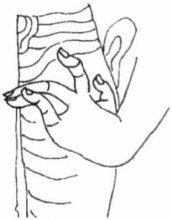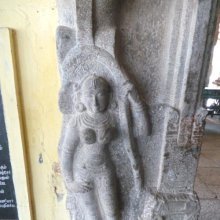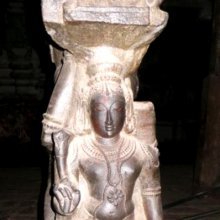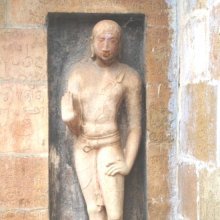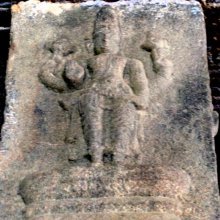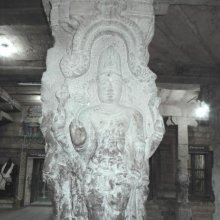Uruhasta, Ūruhasta, Urūhasta, Uru-hasta: 2 definitions
Introduction:
Uruhasta means something in Hinduism, Sanskrit. If you want to know the exact meaning, history, etymology or English translation of this term then check out the descriptions on this page. Add your comment or reference to a book if you want to contribute to this summary article.
Images (photo gallery)
(+35 more images available)
In Hinduism
Shilpashastra (iconography)
Source: Shodhganga: The significance of the mūla-beras (śilpa)Urūhasta (उरूहस्त) or simply Urū refers to “dignified” and represents one of the twenty-four gestures with a single hand, as defined according to texts dealing with śilpa (arts and crafs), known as śilpaśāstras.—Accordingly, pratimā-lakṣaṇa (body postures of the icons) is comprised of hand gestures (hasta, mudrā or kai-amaiti), stances/poses (āsanas) and inflexions of the body (bhaṅgas). There are thirty-two types of hands [viz., urūhasta] classified into two major groups known as tolirkai (functional and expressive gestures) and elirkai (graceful posture of the hand).
(Description of Urū-hasta): This form is similar to the above hasta;the hand is placed on the thigh.
Source: Shodhganga: Vaisnava Agamas And Visnu ImagesŪruhasta (ऊरुहस्त) refers to one of the various hand-poses (hastas or mudrās) defined in treatises such as the Pāñcarātra, Pādmasaṃhitā and Vaikhānasa-āgamas, extensively dealing with the technical features of temple art, iconography and architecture in Vaishnavism.—Ūruhasta and Ūrupratiṣṭhita seems to be same as [Kaṭihasta] but it slightly differs by placement of hand. According to Nāradīyasaṃhitā, the front part of the hand and fingers must be depicted as if in movement. It is observed, “In this, the hand is let down with ease along the side of body and the hand is made to rest on the loin or thigh. However in the seated icon, the hand is bent at elbow. The hand holds the attribute gadā (club) or it bear alapadma-mudrā in which the palm turned downwards remain very close to the thigh”. Another Śilpa text Sakalādhikāra (verse 8.274) assert that the palm must be along the thigh in which the tip of the middle finger remains equal to the edge of meḍhra.

Shilpashastra (शिल्पशास्त्र, śilpaśāstra) represents the ancient Indian science (shastra) of creative arts (shilpa) such as sculpture, iconography and painting. Closely related to Vastushastra (architecture), they often share the same literature.
See also (Relevant definitions)
Full-text (+1): Uru, Shani, Shanaishcara, Urupratishthita, Uma, Gouri, Ambikai, Kanambikai, Venkatacalapati, Sundaraja, Shanishvara, Shrinivasa, Dandayutapani, Balasubrahmaṇya, Ulagalantha Perumal, Shrinivasa-sundaraja, Lingodbhava, Ganga, Sinuvasan, Brahma.
Relevant text
Search found 1 books and stories containing Uruhasta, Ūruhasta, Urūhasta, Uru-hasta, Urū-hasta, Ūru-hasta; (plurals include: Uruhastas, Ūruhastas, Urūhastas, hastas). You can also click to the full overview containing English textual excerpts. Below are direct links for the most relevant articles:
Temples in and around Madurantakam (by B. Mekala)
Atcheeswarar Temple at Acharapakkam < [Chapter 4 - Prominent Temples in Madurantakam Taluk]
Sri Venkateswarar Temple < [Chapter 4 - Prominent Temples in Madurantakam Taluk]
